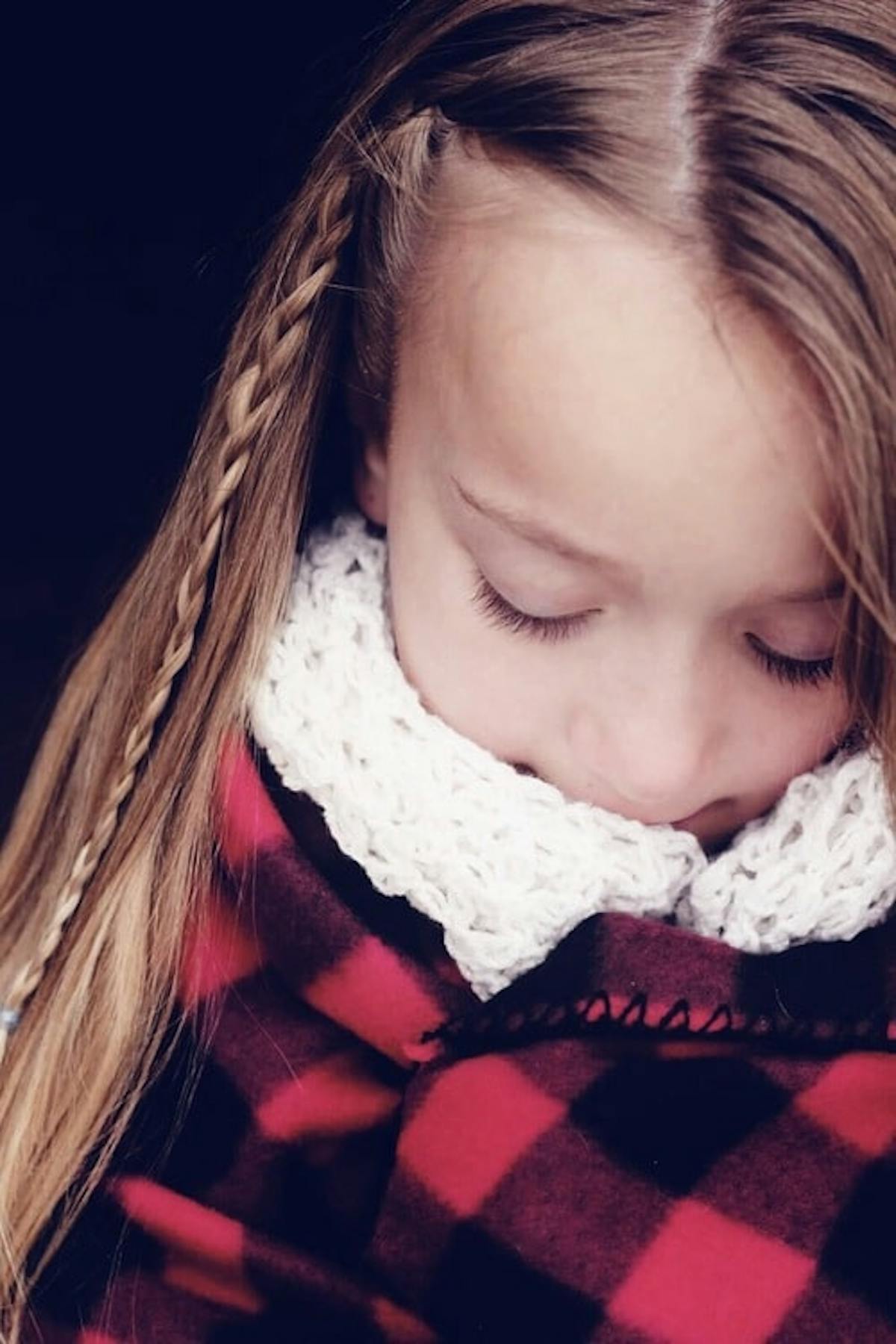Flannel: the sturdy, dependable, warm, and durable fabric that makes cool autumns and even cooler winters cozy and comfortable. Whether you're keeping warm under a flannel blanket, or curled up in a flannel coat, or lounging in your flannel pajamas, there's no denying that the humble fabric makes us feel downright warm and fuzzy. In celebration of flannel, we're diving into the world of flannel, from its definition (and no, plaid and flannel aren't interchangeable, 90s grunge universe), to its applications, types, and care instructions.
What Is Flannel Made Of? (And What Is NOT Flannel?)
Flannel is a fabric that is woven from either carded wool, worsted yarn, cotton, or synthetic fibers. There's also brushing. Brushing is a technique that when applied can add extra softness to flannels. Brushing is a mechanical process and uses a fine metal brush to rub the fabric and raise the fine fibres from the loosely spun yarns to create a napping effect on either one side or both sides. A flannel can either be brushed for that added softness, or be left unbrushed. A flannel that was not napped would gain softness from the woven form itself and its loosely spun yarns.

While these men are all wearing plaid, some are not wearing flannel. Plaid =/= flannel. (Image from Melody Hansen on Flickr - https://www.flickr.com/photos/86264854@N00/2590642044)
While many people use the term “flannel” to talk about plaid or tartan shirts. (We're looking at you Eddie Vedder, Kurt Cobain, and the other faux flannel flaunters of the 1990s). While even some of us here at the Dutch Label Shop sometimes talk about wearing a flannel shirt when we really mean plaid, when talking about the material itself, there is definitely a distinction between a plaid pattern and actual flannel fabric. Plaid refers to the pattern of the fabric, while flannel is the type of fabric.
What Exactly Is A Flannel Weave?
We're talking a lot about how a flannel is distinguished by its weave, but you may be asking yourself what exactly is a flannel weave. Flannel is made using either a twill weave or a plain weave.
A twill weave will create a pattern of diagonal parallel ribbing. The weave is created by passing weft thread (the fiber that is not stretched on the loom) over one or more warp threads (the fiber stretched on the loom), then under two or more warp threads. The pattern continues, with a step (offset) between rows, creating the diagonal pattern that allows the fabric to drape well. A plain weave is the most basic variety of weave (evidenced by its name).
A plain weave involves the warp and weft threads meeting at right angles, forming a simple cross-shaped pattern. The pattern itself is simply one under and one over. The simplicity of this pattern creates fabrics that are both strong and long-lasting.
While both of these weave types have easily identifiable patterns created by their specific patterns, you may be thinking that you don’t often recognize this pattern when looking at your own flannels. This is because the process of napping often hides the pattern itself. Post-weaving, flannels are usually napped once, treated with either bleach, dye, or other methods, and then napped one final time, giving flannel the appearance most of us are familiar with seeing.

What Is Flannel Used to Make?
Flannel, because of its thickness, durability, and ease of use is used to make products designed for cooler weather. You can often find flannel used in making things like clothing, blankets, sleepwear, coats, and bedsheets among other products. Flannel is used to make items designed for cool weather because of its unparalleled ability to hold in heat and absorb moisture. Flannel is also both comfortable and durable, making it an ideal fabric to last through many an autumn night and winter morning.
What Are The Different Types of Flannel?
Most fabrics have different varieties, and flannel is no different. This is in part because flannel is a fabric weave, and the different sorts of fibers that are used can lead to different forms of the flannel fabric. Some popular types of flannel include (but are not limited to):
Baby Flannel
Lightweight and soft, perfect for small children. This variety is wonderfully breathable, making it ideal for comfortable sleeping.
Cotton (or Canton) Flannel
You may have guessed already that this one has something to do with cotton. This variety of flannel is either plain or twill weaved with cotton, and is traditionally napped on just one side and has a twilled surface on the other side. This type of flannel is known for being both warm and absorbent, making it ideal for sportswear, underwear, backings and linings, and sleepwear.
Ceylon Flannel
Ceylon flannel is a blend of cotton and wool. The blend of these two fabrics creates a fabric that is both soft and warm. This combination makes Ceylon flannel ideal for shirts and sheets. There's a good chance your favorite flannel shirt (and we mean REAL flannel, random dude from 1993 Seattle) is produced using Ceylon flannel.
Flannelette
Just like satin has sateen, flannel has flannelette. Flannelette is a napped cotton fabric that aims to imitate the feeling and texture of flannel. Flannelette tends to have a coarser warp. Its flannel appearance comes from napping the weft side of the fabric, by scratching it and raising it up. Flannelette is most often seen in sleepwear, pillows, and bedding.

Choosing Flannel Fabrics For Your Project
Quality matters. While flannel may be humble, unflashy, and utilitarian compared to flashy satin or luxurious leathers, that doesn't mean that you can skimp on quality when working with flannel. We will repeat it often and always: the tighter the weave, the higher the quality. The looser the weave, the lower the quality. Tight weaves mean more durability; loose weaves mean more opportunities to warp, shrink, or stretch in ways most wouldn't intend. When picking out flannels, here are a few tips to make sure that you're picking a good quality flannel fabric:
Weight
You can measure the worth of your flannel in weight. The lighter it is, the cheaper it is. You want to make sure you get a flannel with a good weight, because a few ounces can be the difference between a project that will hold its shape and one that will either stretch out of shape, shrink, or somehow horrifically do both. This is due to the fact that the looseness or tightness of the weave can often be associated with the weight of the fabric; the looser the weave, the lighter the fabric, and vice versa. For cotton flannels, you should go for something that weighs at least 5 oz./square yard, and ideally over 6.5 oz./square yard. Wool flannels are heavier, due to the heavier fiber, and usually range from 10-20 oz./square yard, and like cotton, the heavier the fabric, the better the quality.
Appearance
The weave of flannel is often hard to see due to the napping and brushing processes it has undergone. However, if you hold up your flannel to the light, you can get a better look at the weave. Tightness is, well, tight. And, of course, as we have said over and over again, it's an indicator of how well your fabric will hold up, and looseness is for loosers, and will cause many heartbreaks when it stretches or shrinks.
Touch
There's a reason people love flannel, and you should be able to feel it right away when you pick up a nice quality flannel. It should feel soft to the touch. That's why it's always important to feel your flannel out before proceeding. While you may not be able to get out to your local fabric store, you can always ask for samples to be sent to you before making a purchase for a project. Samples are also great for pre-washing and testing out the durability of the fabric in your washer and dryer.

Working With Flannel
Flannel weaves, whether twill or plain, tend to be loose. Loose weaves mean that the fabric will have a good deal of stretch while sewing, and a good chance of shrinking when washing. Due to its nature, it's strongly recommended that you pre-wash flannels before starting any project using a flannel fabric. When drying the flannel pre-project, you'll want to use the maximum heat setting on your dryer, to ensure you're getting as much of the fabric shrinkage possibilities maxed out before starting to sew. The dryer will also have the added bonus of removing a good deal of lint and fuzziness before sewing, too.
You'll also want to press your flannel before beginning your project. You will want to use an iron, but don't actually iron the fabric. Instead, press the fabric. Hold the iron in place for a few seconds, lift, and repeat. If you iron the fabric by sliding the iron across, this will distort your flannel and lead to unwanted stretching.
Flannel is also one of those fabrics that is way too easy to fray. This is why the simpler the design or pattern, the better. You'll also want to select larger pieces of fabric when creating quilts, and even for clothing designs you'll want to cut your pieces a little larger than usual, and then allow an increased seam allowance between ¼” and ½”.
Because flannel is so thick and sturdy, the fabric can often dull needles. Dull needles can mean missed or uneven stitches, and who wants that? That's why you should be sure to use a new needle whenever you start a new project with flannel. You will also want to keep your sewing machine clean throughout the process, because of flannel's tendency to leave a trail of lint on your sewing machine and table.
Caring For Flannel
The way you're going to wash your flannel once you have a completed project is nothing like the pre-washing phase. When you pre-washed, you wanted to shrink the fabric to try to avoid further shrinking in the future. Now that you have a completed project, you don't want anymore shrinkage. That's why it's important to follow the care instructions for your flannel, and a smart idea to add a care label to your flannel creations to avoid shrinking in the future.
To properly wash flannel, you will need to:
- Wash your flannel at the lowest setting in cold water with mild detergents
- Make sure your washer and dryer are not overloaded when washing your flannel.
- Be mindful of what's sharing space with your flannel in the washing machine. The worst thing is having to clean the flannel lint off of your favorite sweater.
- Hang dry your flannels when possible, to avoid losing color of having your flannels appearance fade over time.
- When ironing, iron on the wrong side of the fabric.
Have Fun!
The most important thing about your flannel project (or any project) is to have fun. Whether you're making a quilt, a pair of pajamas, or a cozy shirt for your authentic Smashing Pumpkins cosplay, pick something that you'll enjoy creating and using long after your project is finished.
And of course, on top of the care labels, you'll want to add your own personalized label as well.
Have your own flannel fabric tips, tricks, or thoughts. Let us know in the comments here or reach out to us on Instagram, Facebook, or Twitter using #dutchlabelshop.













